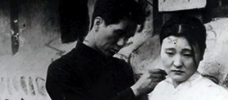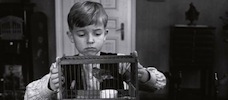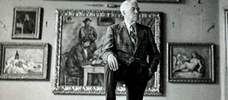Reviews
Don Argott
USA, 2009
Credits
Review by Jenny Jediny
Posted on 11 October 2009
Source Sundance Selects/IFC Films 35mm print
Categories The 47th New York Film Festival
It’s apparent from the title alone whose side Don Argott’s documentary is on: centered around the controversial “theft” of a private collection of art that appears to have been engineered by a multitude of suspects (a slew of bureaucratic characters, ranging from corporate empires to the city of Philadelphia itself), The Art of the Steal is buoyant in style, with slick editing and a high-energy soundtrack. (I wouldn’t have thought to combine Black Sabbath with fine art, but it is invigorating.) Tackling a dense and nearly century-old rivalry between an independent art collector and moneyed Philadelphians, Steal also raises some considerable - and debatable - questions about how we look at art.
If you despise the era of the blockbuster art show (“Van Gogh and Gauguin,” “Tutankhamun and The Golden Age of the Pharaohs” - i.e., an art show requiring advance ticketing), it’s hard not to sympathize with the “Friends of the Barnes Foundation”, the self-proclaimed protectors of an art collection currently in the midst of a tangled legal battle. Founded in 1922 by a pharmaceutical entrepreneur, the Albert C. Barnes Foundation houses one of the most exquisite art collections in the world, its value inestimable. Press notes proclaim over $25 billion, and it’s quite a bundle: Matisse, van Gogh, Seurat, Picasso, sculptures and ancient artifacts. It’s enough to make any art lover (or curator) drool with envy.
However, the original reception was far from glowing, as the Philadelphia art world (not merely its high-societal patrons but critics as well) scoffed, as the majority of the artists comprising Barnes’ collection, particularly the Impressionists, had yet to achieve the critical and popular status they hold today. Dr. Barnes, a bit of a badass, licked his wounds and created his Foundation, limiting his collection to students alone, while honoring the occasional viewing request, particularly from the common man. When the rest of the art world caught up with Barnes’ curatorial taste, it was too late — Barnes not only refused to go public, but denied viewings to everyone from the New York Times’ art critic to the wealthiest families in Philadelphia, including the Annenberg family (now one of the largest non-profit supporters, from museums to PBS). Publicly mocking these figures, Barnes became notoriously despised, fueling a fire that’s lasted decades after his death in 1951, and led to the gradual, controversial steps now almost certainly forcing Barnes’ collection out of its home and into a new building with “enhanced” public access.
While the war rages on (the Barnes collection is still scheduled to shift buildings in 2011, although further legal action continues to challenge the move), The Art of the Steal’s portrayal, although underdeveloped, of the way we view art as commodity reaches beyond Barnes and back to the problem of the blockbuster. While the supporters for the new Barnes building argue accessibility, the fact remains that the collection is already accessible, albeit in its original, smaller building in the Philly suburbs, with shorter visiting hours and the lack of a parking lot. But not every art collection is created for busloads of tourists — the contrast is easily discernable between Barnes’ curatorial taste (closely positioning paintings, à la early schools of art, among carefully chosen objects) and the familiar museum display (white-walls and wide spacing between individual paintings, and wings separating not only schools of art, but continents and eras). Barnes’ method was intent on a kind of education that large museums cannot provide, and the potential loss of this intimacy in a new space is a genuine shame.
While we’re not provided with an ample amount of verbal statements from the opposing side (by their own refusal) and there’s almost too much testimony from supporters of Barnes, resulting in a bit of “talking-head” syndrome, The Art of the Steal does tell a captivating tale. Barnes stipulated in his will that the collection could never be loaned, sold, or otherwise removed from the building specifically built to house them, personal wishes all broken at this point (minus a sale). As Barnes had no children, responsibility for the Foundation switched hands until inevitably, Barnes’s attempts to protect his beloved collection only made it more vulnerable. But The Art of the Steal, while lining up the suspects, can’t entirely untangle the mystery. However one may view the impending move of the Barnes Collection - as an overdue benefit to both the economy and public of Philadelphia, or a highly corrupt takeover decades in the making - it remains disturbing how a supposedly airtight document was all too easily picked apart.
More The 47th New York Film Festival
-

Sweetgrass
2009 -

Kanikosen
2009 -

Police, Adjective
2009 -

Antichrist
2009 -

Wild Grass
2009 -

Lebanon
2009 -

Crossroads of Youth
1934 -

The White Ribbon
2009 -

Mother
2009 -

Min Ye
2009 -

The Art of the Steal
2009 -

In Comparison
2009
We don’t do comments anymore, but you may contact us here or find us on Twitter or Facebook.



